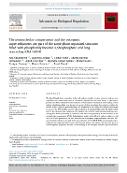The perinucleolar compartment and the oncogenic super-enhancers are part of the same phase-separated structure filled with phosphatidylinositol 4,5-bisphosphate and long non-coding RNA HANR

Author
Miladinović, Ana
Antiga, Ludovica
Venit, Tomáš
Bayona-Hernandez, Andrea
Labala, Rajendra Kumar
Kolář, Michal
Castaño, Enrique
Hozak, Pavel
Publication date
2025Published in
Advances in Biological RegulationVolume / Issue
95 (January)ISBN / ISSN
ISSN: 2212-4926ISBN / ISSN
eISSN: 2212-4934Metadata
Show full item recordCollections
This publication has a published version with DOI 10.1016/j.jbior.2024.101069
Abstract
The liquid-liquid phase separation in the cell nucleus regulates various processes such as gene regulation and transcription control, chromatin organization, and DNA repair. A plethora of proteins and RNAs contribute to the formation of biomolecular condensates and recently, several nuclear phosphoinositides were shown to be a part of these membrane-less complexes within the nucleus as well. Here we lipid-interacting RNA sequencing (LIPRNAseq) and confocal microscopy to uncover the RNA-binding capacity and localization of phosphatidylinositol 4,5 bisphosphate (PIP2). We discovered the consensus PIP2-binding AU-rich RNA motif and identified long non-coding RNA HANR (lncHANR) to colocalize with PIP2 in the proximity to the nucleolus in the perinucleolar compartment (PNC). Colocalization studies with different nuclear markers reveal that PIP2-HANR presence in the PNC correlates with oncogenic super-enhancers, and both PNC and oncogenic enhancers are part of the same structure. As lncHANR, PNC, and oncogenic super-enhancers are associated with cancer cell lines and tumors, we suggest that they can serve as interchangeable prognostic markers. Understanding of the interplay between lipid metabolism, and lncRNAs in subnuclear compartment phase separation can lead to future improvement in treatment strategies and personalized cancer management approaches.
Keywords
HANR, Long non-coding RNA, Oncogenic super-enhancers, PIP2, PNC, Perinucleolar compartment, Phase separation, Phosphatidylinositol 4,5-bisphosphate
Permanent link
https://hdl.handle.net/20.500.14178/2752License
Full text of this result is licensed under: Creative Commons Uveďte původ 4.0 International







